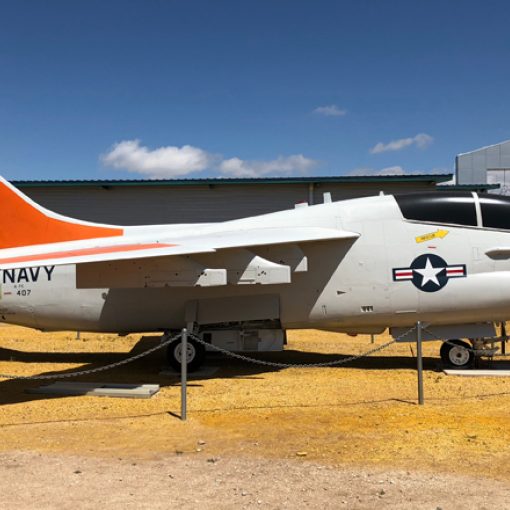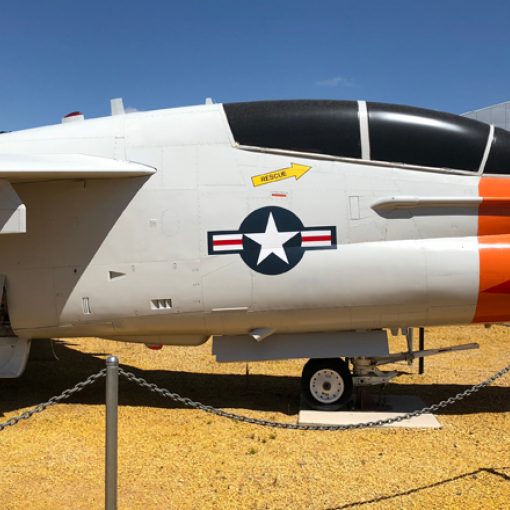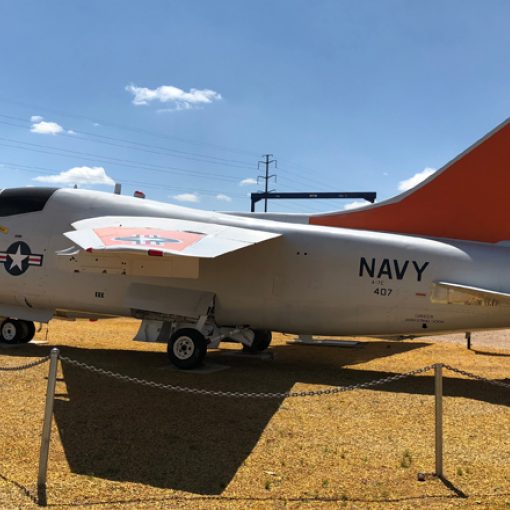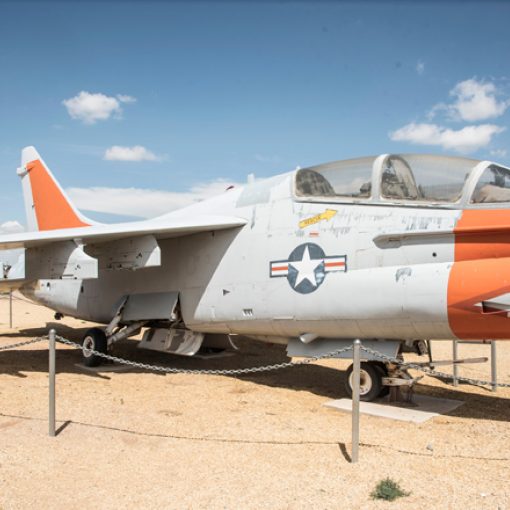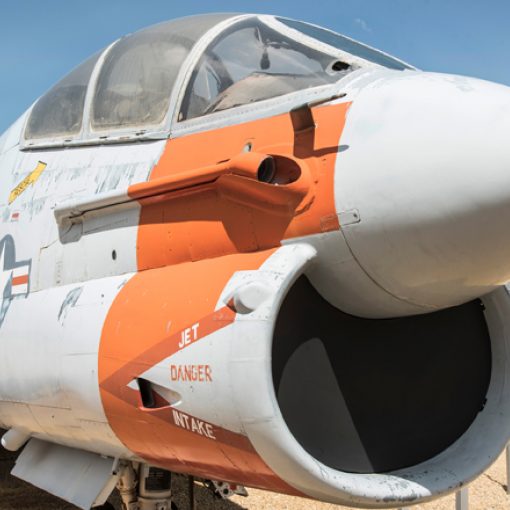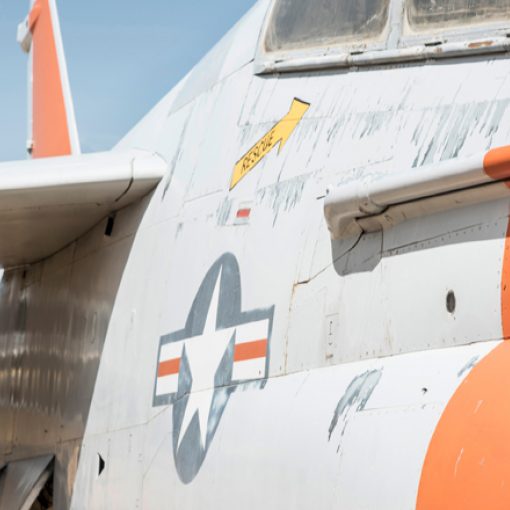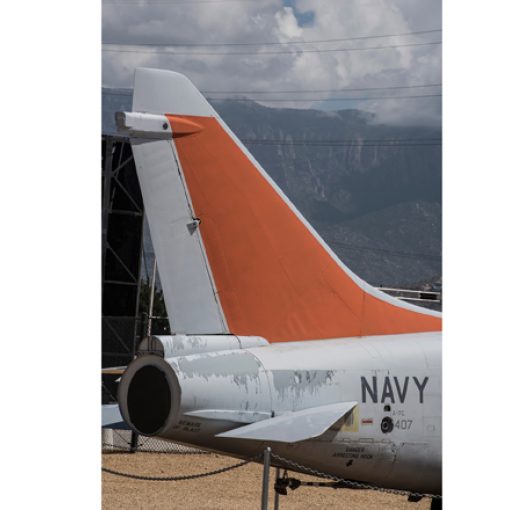Completed A-7 Corsair II
Two of the National Museum of Nuclear Science & History’s iconic fighter-bombers, the F-105D Thunderchief
and the A-7 Corsair II, were the focus of the museum’s special
initiative within Operation Preservation—a multi-year campaign to
repaint and refurbish the airplanes in the museum’s nine-acre outdoor
exhibit area known as Heritage Park in the spring and summer of 2017.
The second aircraft to receive restoration attention that spring and summer was the museum’s A-7 Corsair II, Bureau Number 154-407, the only aircraft in the museum’s collection to have ever flown in combat missions. This Navy carrier fighter bomber was built in 1968, and in its first eight years in service, the aircraft saw numerous cruises, including several Vietnam deployments. It had 3,338 flight hours and 731 carrier launches and landings within this timeframe.
This aircraft was modified and upgraded over the next few years. It was stationed at two different Naval Air Stations where it was continually involved in flight test work until its aircraft lifetime expired. During its service, it was instrumental in training pilots in nuclear weapons delivery tactics and in developing and testing weapons for weapon delivery. Its last flight was to Albuquerque, where it was used for parts and training, having accumulated 5,796.6 flight hours. It joined the museum’s collection in 1992.
The A-7 was, from 1967 until 1992, one of the most cost-effective and capable attack aircraft in the Navy’s inventory. The museum’s A-7 Corsair II is a TA-7C model, converted from a single-seat A-7E to a two-seat TA-7C in 1976. Built by Ling-Temco-Vought (LTV) Aerospace Corporation – with a length of 46 feet and 2 inches and a wingspan of 38 feet and 9 inches – a total of 1,569 A-7 aircraft were produced, fighting in both Vietnam and Iraq. Although they were not the fastest aircraft, they had a solid reputation with pilots as reliable aircraft that could accurately deliver weapons. It also holds the distinction of being the only single-seat jet fighter bomber that was designed, built, and deployed into combat, all during the Vietnam War.
Restoration of both aircraft began in April of 2017 under the supervision of General Jay Bledsoe,
Project Manager, with the help of museum staff and volunteers. The restoration will be funded by donations from supporters and entities with
personal ties to the museum and the historic aircraft. The F-105D was
the first aircraft to be repainted, receiving trim and insignia to look
as it did when it was active in the 49th TFW in Germany as part of NATO.
After its completion, the focus moved toward the A-7, repainting the
surface to revive the paint colors of orange and grey. The total
restoration cost for the F-105D Thunderchief and A-7 Corsair II was
$45,000.
Completion of these outdoor exhibits for visitor viewing occurred in winter 2018.
The museum has successfully restored three other aircraft in Heritage Park, including the F-16 Fighting Falcon, the B-29 Superfortress, and the B-52 Stratofortress. More information about new restoration initiatives and completed projects can be found online at nuclearmuseum.org.
The National Museum of Nuclear Science & History launched an ambitious campaign through Indiegogo - a funding platform for creative projects, directly supported by individuals who pledge money - April 14 through May 14, 2017 - to purchase the paint for the restoration of the museum’s iconic F-105 and A-7.
Since one gallon of paint for these airplanes costs $460 and one gallon of primer costs $300, the Museum’s staff decided to incorporate Indiegogo to ‘kick start’ the fundraising aspect of the restoration projects. Through the generosity of 86 backers, the museum raised $9,605 to help pay for paint and primer.
Thank you to the following supporters:
$500 Supporters:
Milo Myers
William Scott Handy
$250 Supporters:
Ryan Brukardt, Jennifer Cline, Donald Hall, Robert Hammerstein, Thomas Rose
$100 Supporters:
Kristin Bush, Damon Giovanielli, Jeffrey Mahn, Jim Saunders, Nicholas Shanayda
$50 Supporters:
Robert and Suzanne Busch, Andrew Funk, Stephen Greeley, William Clay Jones, James R. Reddin, Perry Robertson, Steven Shook, Jeff Terry
$10 Supporters:
Paul Carbin, Jean and Roger Cox, Lorenzo Dutto, John Hodges, George Laskar, Thomas M. Lore, Kelly D. Michals, Calvin Shields, Nicholas M. Williams
